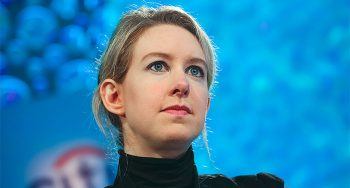Melanie McFarland in AlterNet:
 Look at me, the con artist says. Watch closely so you can see everything I’m doing. We can’t, of course, because we’re not meant to. Yet we fall for frauds because we so want what they promise to be true: easy money, better solutions, painlessness and efficiency. Elizabeth Holmes, the woman at the center of the Theranos scandal and the central subject of “The Inventor: Out for Blood in Silicon Valley,” dangled all of these offers in front of the world using showy language, a moving personal story and the appearance of expertise and vision. She parlayed her youth, her intellect, her unwavering commitment to success and her connections to raise hundreds of millions of dollars in venture capital out of air. By the time she had scammed powerful politicians, wealthy media magnates and an entire drug store chain, she’d amassed enough money to become, for a short time, the world’s youngest self-made billionaire. As in truly self-made, not Kylie Jenner self-made. Holmes did not benefit from the cushion of fame or industry wealth. What she had was a story.
Look at me, the con artist says. Watch closely so you can see everything I’m doing. We can’t, of course, because we’re not meant to. Yet we fall for frauds because we so want what they promise to be true: easy money, better solutions, painlessness and efficiency. Elizabeth Holmes, the woman at the center of the Theranos scandal and the central subject of “The Inventor: Out for Blood in Silicon Valley,” dangled all of these offers in front of the world using showy language, a moving personal story and the appearance of expertise and vision. She parlayed her youth, her intellect, her unwavering commitment to success and her connections to raise hundreds of millions of dollars in venture capital out of air. By the time she had scammed powerful politicians, wealthy media magnates and an entire drug store chain, she’d amassed enough money to become, for a short time, the world’s youngest self-made billionaire. As in truly self-made, not Kylie Jenner self-made. Holmes did not benefit from the cushion of fame or industry wealth. What she had was a story.
Holmes dropped out of Stanford at 19 and as she charged into the field of biotech, she styled her approach after other great visionaries, such as Steve Jobs and Thomas Edison. She said all the right things and projected the right image. At the height of her company’s fortune, it was valued at $9 billion. If only that estimated worth was based on a product that actually worked. “The Inventor,” debuting Monday at 9 p.m. on HBO, is but the latest examination of massive fraud to draw the public’s attention and fascination. We’re still reeling over the college bribery scandal currently dominating the headlines, which broke only a few months after Hulu’s and Netflix’s separate looks at the Fyre Fest long con became top gossip at the water cooler.
More here.
